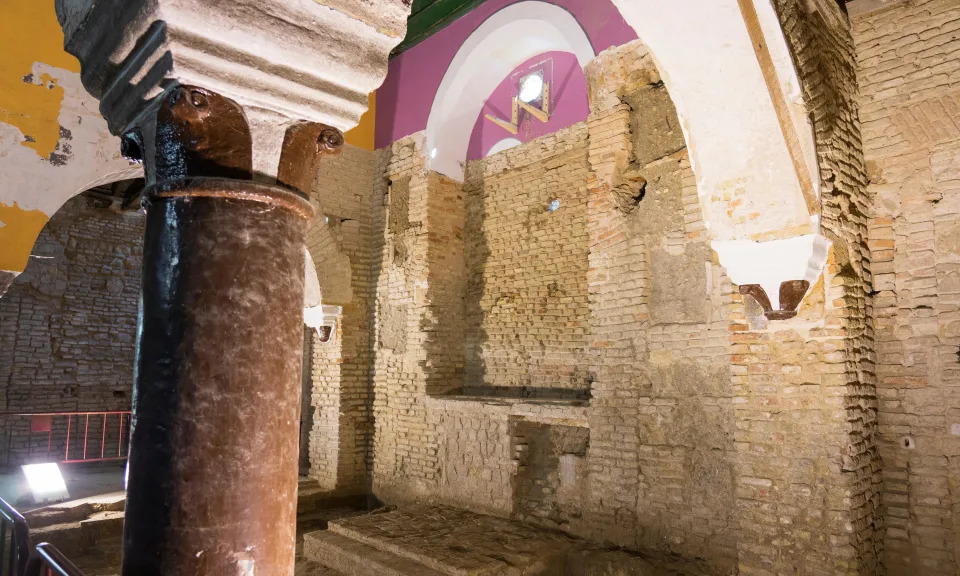Sam Jones in Madrid
Tue, 7 February 2023

Archaeologists in the Andalucían city of Utrera have rediscovered a staggeringly rare Spanish medieval synagogue, which was later used over the course of seven centuries as everything from a hospital and a home for abandoned children to a restaurant and disco-pub.
The find, announced on Tuesday, makes the 14th-century building one of a precious handful of medieval synagogues to have survived the aftermath of the expulsion of Spain’s Jews in 1492.
References to the lost temple go back more than 400 years. In his 1604 history of Utrera, Rodrigo Caro, a local priest, historian and poet, described an area of the city centre as it had been in earlier centuries, writing: “In that place, there were only foreign and Jewish people … who had their synagogue where the Hospital de la Misericordia now stands.”
Caro’s assertion was verified at the end of last year when a team led by the archeologist Miguel Ángel de Dios discovered the Torah ark area and the prayer hall.
“It was like cracking hieroglyphics. Once we had that key, it all came together,” he said.
Related: Could a former bar be one of Spain’s lost medieval synagogues?
Speaking at a press conference at the site on Tuesday morning, Utrera’s mayor, José María Villalobos, said the two-year search had meant “we can now be scientifically certain that we’re standing in a medieval synagogue right now”.
He said the importance of the “extraordinary” find was difficult to overstate.
“Until now, there were only four such buildings in all of Spain – two in Toledo, one in Segovia and one in Córdoba,” he said. “This is an exceptional building that’s been part of Utrera and part of its inhabitants’ lives for 700 years. This building was born in the 1300s and has made it all the way to the 21st century.”
One of the key reasons for its survival, he added, was the fact that it had always been in use for one purpose or another.
He said the discovery had vindicated the city council’s not-always-popular decision to purchase the property for €460,000 (£410,000) four years ago, and that it represented “an opportunity for us to recover our history” and to attract researchers and tourists.
The plan is to open for public visits in parallel with the continuing archaeological works. Although the women’s area and the ritual bath have yet to be discovered, the site could yet give up many more secrets, according to de Dios. The next phase of the investigation would be looking to see if there was a rabbinical house nearby and perhaps a religious school.
But the significance of the find exceeds the merely architectural, he said.
“Apart from the heritage value – this is a building with an important history that was once a synagogue – the thing that makes me happiest is knowing that we can get back a very, very important part of not just Utrera’s history, but also the history of the Iberian peninsula,” he said. “The story of the Sephardic Jews was practically erased or hidden for a long time.”
While people know about Islamic Spain thanks to its myriad cultural, linguistic, gastronomic and architectural legacies, the story of the Jews who once called the peninsula home is far less familiar.
It was only in 2015 that the Spanish government passed a law offering citizenship to the descendants of the Jews expelled in 1492 in an attempt to atone for what the then government termed a historic mistake. More than 130,000 people applied for citizenship under the scheme before it ended in 2019.
De Dios hopes the discovery of the synagogue-cum-hospital-cum-children’s-home-cum-bar will help Spaniards reflect on their past and their present.
“This is like a window, or like a megaphone through which the Sephardic Jews can speak to us,” he said.
“If we’re so minded, we can listen and learn a lot of things about who we are and why we’re where we are. It’s an opportunity to think about where the Sephardic diaspora is now. It’s a unique opportunity and we shouldn’t get too hung up on the building and its four walls.”
No comments:
Post a Comment